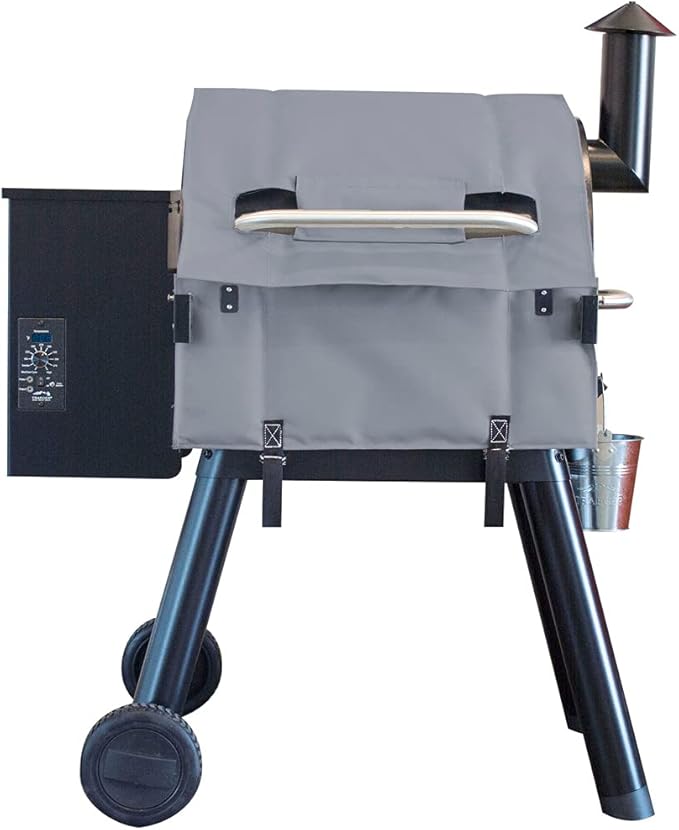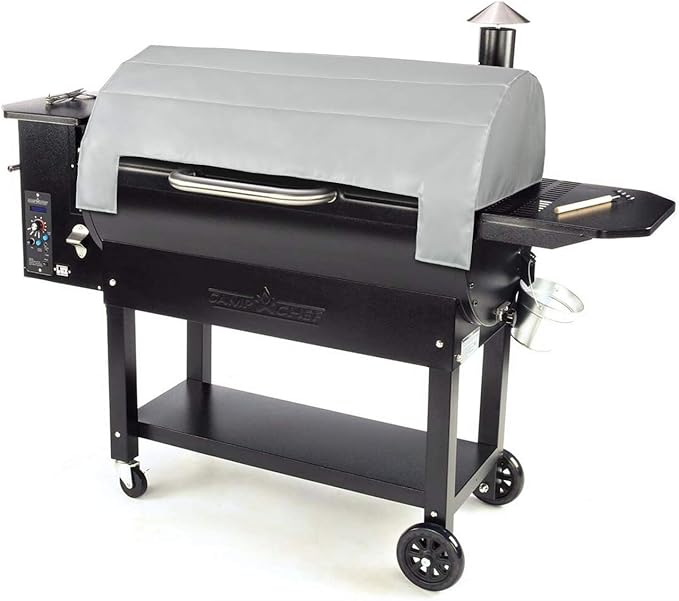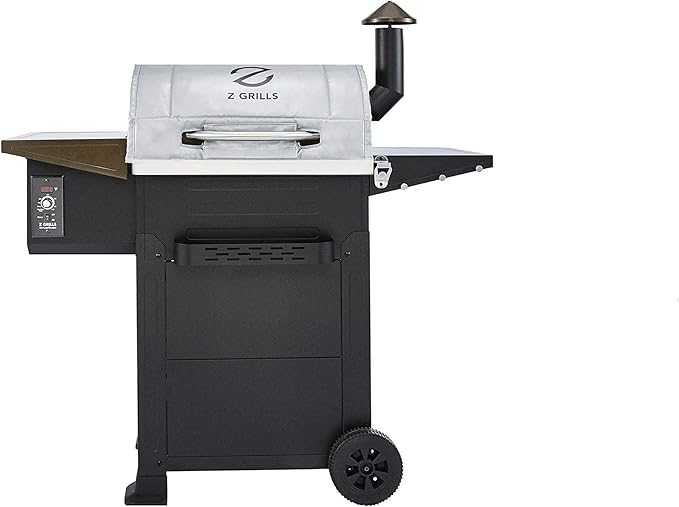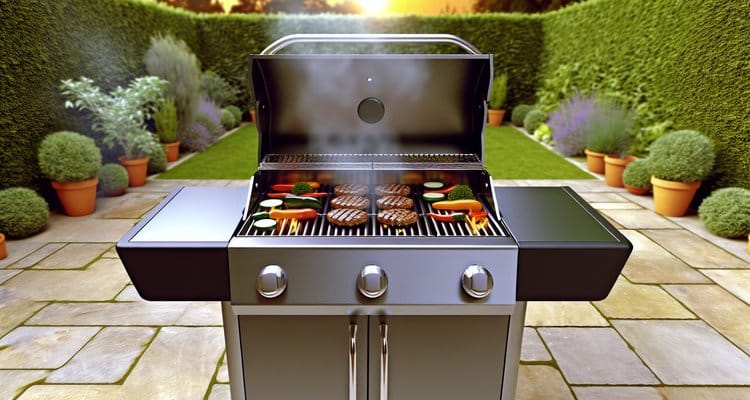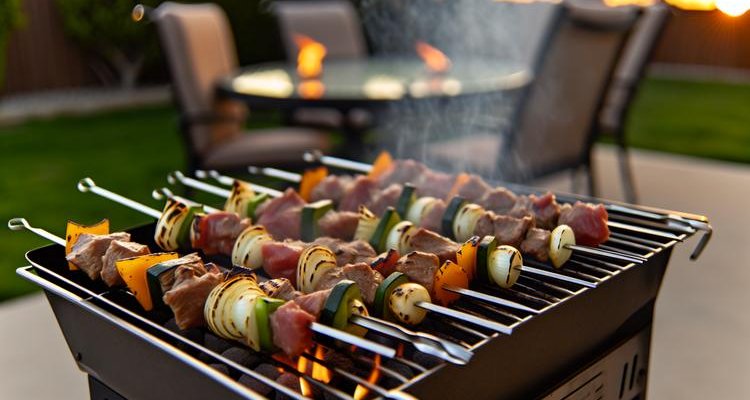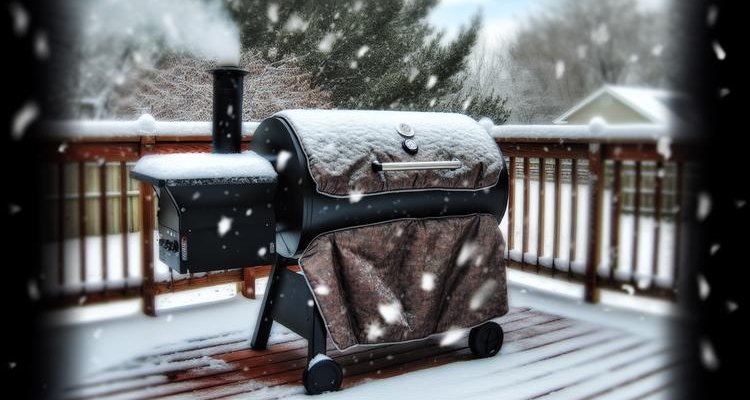
Winter grilling presents unique challenges that can frustrate even the most dedicated outdoor cooking enthusiasts. When temperatures drop below freezing, pellet grills and smokers struggle to maintain consistent heat, pellet usage skyrockets, and achieving proper cooking temperatures becomes an uphill battle. The metal construction that makes these grills durable also becomes a liability in cold weather, as metal absorbs cold faster than it retains heat.
A grill insulation blanket offers the solution to these cold weather grilling challenges. These specialized thermal covers wrap around your pellet grill or smoker’s combustion chamber, creating a protective barrier that retains heat and shields your grill from harsh winter conditions. The results are impressive: up to 50% reduction in pellet consumption, dramatically improved temperature stability, and the ability to grill year-round regardless of outdoor conditions.
In this comprehensive guide, we’ll walk you through everything you need to know about grill insulation blankets. You’ll discover how these thermal covers work, why they’re essential for cold weather grilling, and most importantly, we’ll provide detailed reviews of the top 6 options available for popular grill brands including Traeger, Camp Chef, Z GRILLS, and Pit Boss. Whether you’re battling Wisconsin winters or simply want better fuel efficiency during cooler months, this guide will help you choose the perfect thermal blanket for your specific grill model.
Quick Roundup List
- Best Overall: Stanbroil for Traeger 34 Series
- Best for Traeger Pro Series: BBQ Butler Pro 575/22
- Best for Camp Chef: Stanbroil 36″ Smokepro
- Best Budget: Z GRILLS ZPG-450A
- Best for Larger Grills: Z GRILLS 600/700 Series
- Best for Pit Boss: Hisencn Pro 850/800
Why You Need a Grill Insulation Blanket
Cold Weather Grilling Challenges
Understanding the physics of cold weather grilling helps explain why insulation blankets are so effective. Metal, the primary material in pellet grill construction, is an excellent conductor of both heat and cold. While this property helps distribute heat evenly during normal conditions, it becomes a significant disadvantage when outdoor temperatures plummet.
When you’re grilling in cold weather, the metal exterior of your pellet grill rapidly absorbs the surrounding cold air, creating a constant battle for your heating system. Every time you open the lid to check your food or add seasoning, warm air escapes and cold air rushes in, causing dramatic temperature drops that can take 15-20 minutes to recover. This temperature instability doesn’t just inconvenience you—it directly affects cooking times, smoke production, and ultimately, the quality of your barbecue.
The pellet consumption problem becomes particularly severe below 35°F. Without proper insulation, your grill’s auger works overtime to maintain target temperatures, burning through pellets at rates 50-75% higher than normal conditions. Real-world testing shows uninsulated grills consuming 3.3 pounds of pellets per hour in freezing temperatures, compared to just 2 pounds per hour with proper thermal insulation. For frequent winter grillers, these fuel costs add up quickly.
The Solution: Thermal Insulation
A thermal blanket for your grill acts as a protective barrier between the frigid outside air and your grill’s combustion chamber. By wrapping around the metal exterior, the insulation blanket prevents heat from escaping through the grill walls while simultaneously blocking cold air, wind, and precipitation from affecting internal temperatures.
The science behind heat retention is straightforward: multiple layers of fire-resistant material create air pockets that trap warm air near the grill surface. This insulating layer reduces the temperature differential between the interior cooking chamber and the exterior metal walls, allowing your pellet grill to maintain consistent temperatures with significantly less fuel consumption.
Modern grill insulation blankets also provide crucial protection from wind, which can dramatically accelerate heat loss through convection. Even in moderate temperatures around 45-50°F, strong winds can create conditions equivalent to much colder weather. The insulation blanket shields your grill from these wind effects, ensuring stable cooking temperatures regardless of weather conditions.
When You Need an Insulation Blanket
The 35-40°F threshold serves as the general guideline for when to deploy your grill insulation blanket. Below this temperature range, most pellet grills begin experiencing noticeable performance degradation without thermal protection. You’ll observe longer preheat times, difficulty maintaining high-heat searing temperatures, and increased pellet consumption.
However, temperature alone doesn’t tell the whole story. Wind conditions significantly impact when you should use an insulation blanket. A calm 40°F day may not require insulation, but add 15-20 mph winds and you’ll want that thermal protection. Similarly, if you’re attempting low-and-slow smoking sessions lasting 8-12 hours in temperatures below 50°F, an insulation blanket ensures consistent results throughout the entire cook.
Conversely, avoid using thermal blankets when outside temperatures exceed 60°F in calm conditions. The additional insulation can cause your grill to run too hot, potentially leading to temperature control issues and unnecessary wear on your heating elements. Most manufacturers specifically recommend against use above 40°F, as the blanket’s insulating properties become counterproductive in warmer weather.
How Grill Insulation Blankets Work
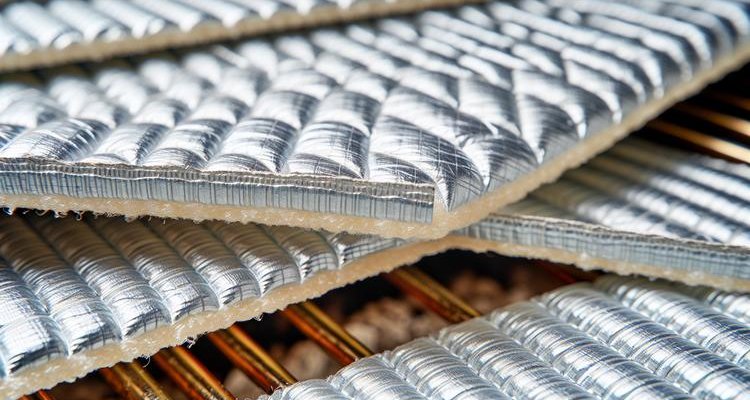
Construction and Materials
The effectiveness of a grill insulation blanket depends entirely on its construction and material quality. Modern thermal blankets use fire-resistant fiberglass fabric as the primary material, offering both exceptional heat tolerance and long-term durability. This isn’t the same fiberglass used in home insulation—it’s specifically engineered to withstand direct contact with surfaces that can reach 400-500°F during grilling operations.
Premium insulation blankets feature multi-layer construction that maximizes thermal performance. The typical design includes an inner aluminum-coated fiberglass layer that reflects radiant heat back toward the grill, a middle layer of insulating cotton or fiberglass batting that traps warm air, and an outer protective coating—often polyurethane (PU) or silicone fabric—that provides waterproofing and oil resistance.
The attachment system represents another critical design element. Most quality blankets use heat-resistant magnets strategically placed to hold the blanket securely against the grill’s metal exterior. These rare-earth magnets maintain their magnetic properties even at elevated temperatures, ensuring the blanket stays in place during windy conditions. Some models incorporate adjustable strap systems as an alternative or supplementary attachment method, allowing for secure installation on grills with less magnetic-friendly surfaces.
Importantly, grill insulation blankets are designed to cover only the combustion chamber—the main cooking area where temperature control matters most. They deliberately leave vents, chimneys, and control panels exposed to ensure proper airflow and accessibility. This targeted coverage approach provides maximum thermal benefit while maintaining safe operation.
Heat Retention Science
The thermal dynamics of an insulated pellet grill involve three key heat transfer mechanisms: conduction, convection, and radiation. Without insulation, heat conducts through the metal walls and radiates into the surrounding cold air, while wind-driven convection accelerates this heat loss. An insulation blanket interrupts all three processes simultaneously.
Conduction loss—heat traveling through the metal walls—gets blocked by the insulating material’s low thermal conductivity. The air pockets within the blanket’s layers act as thermal barriers, dramatically slowing the rate at which heat moves from the warm interior to the cold exterior surface. This temperature control benefit means your grill’s heating element doesn’t have to work continuously to compensate for heat loss.
Radiation heat loss, where infrared energy escapes from the hot metal surface, is addressed by reflective aluminum layers within many premium blankets. These metallic layers bounce radiant heat back toward the grill chamber rather than allowing it to escape into the atmosphere. The result is a more stable internal environment that maintains target temperatures with minimal fuel input.
Convection protection—shielding the grill from wind-driven heat loss—provides some of the most dramatic performance improvements. Even moderate winds can strip away the warm air boundary layer surrounding your grill, forcing the heating system to work harder. The thermal blanket creates a protective shell that eliminates this wind chill effect, ensuring consistent performance regardless of breezy conditions.
Form-Fitting vs Universal Design
Brand-specific grill insulation blankets are engineered with precise dimensions to match particular grill models. A Traeger 34 Series blanket, for example, is custom-patterned to conform perfectly to that grill’s unique shape, with cutouts positioned exactly where controls, handles, and vents are located. This precision fit eliminates gaps where heat could escape and ensures the magnetic or strap attachment points align perfectly with the grill’s metal panels.
The advantage of brand-specific designs becomes obvious during installation. These blankets simply drape over the designated coverage area and secure in place with minimal adjustment. The custom fit also means the blanket doesn’t interfere with normal grill operation—you can access temperature controls, open the lid, and check your food without removing the blanket entirely.
Universal insulation blankets attempt to accommodate multiple grill sizes and brands through adjustable designs or oversized dimensions. While these can provide reasonable thermal performance, they typically require more effort to install correctly and may not achieve the same seamless coverage as brand-specific options. Gaps, loose areas, and poor alignment with controls are common issues with universal designs.
For serious winter grilling enthusiasts, the investment in a properly fitted, brand-specific insulation blanket delivers superior performance and convenience compared to universal alternatives. The custom engineering ensures maximum heat retention efficiency and the easiest possible installation process.
Benefits of Using Insulation Blankets
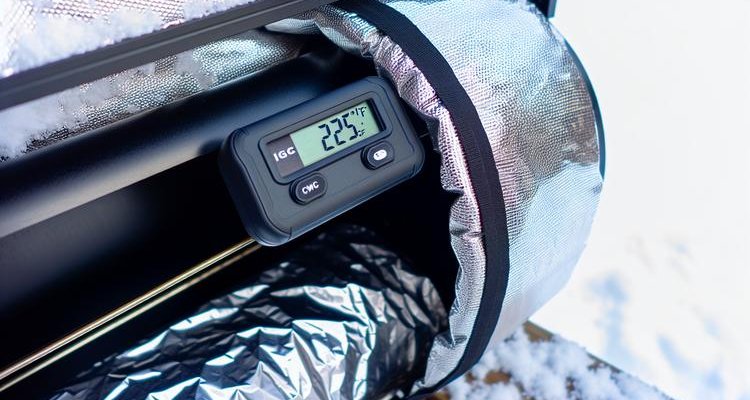
Fuel Efficiency and Cost Savings
The most immediately noticeable benefit of using a grill insulation blanket is the dramatic reduction in pellet consumption. Field testing consistently demonstrates 25-50% fuel savings when using thermal insulation in temperatures below 40°F. These aren’t theoretical numbers—they represent real-world results from countless winter grilling sessions.
To put this in perspective, consider a typical 8-hour smoking session in 30°F weather. An uninsulated pellet grill might consume 25-30 pounds of pellets maintaining 225°F. That same session with a quality insulation blanket requires just 15-18 pounds of pellets for identical results. For winter grilling enthusiasts who smoke multiple times per month, the blanket pays for itself within a single season.
The fuel efficiency improvement extends beyond just saving money. Reduced pellet consumption means fewer mid-cook refills—a significant convenience during long smoking sessions. Instead of monitoring the hopper and adding pellets every few hours, your grill can run longer on a single fill, allowing you to focus on other aspects of your cook or simply enjoy time with family and guests.
Long-term, this improved fuel efficiency also reduces wear on your grill’s auger motor and heating elements. When your grill isn’t working overtime to maintain temperature, mechanical components experience less stress and last longer. The thermal protection an insulation blanket provides translates to extended equipment lifespan and lower maintenance costs over the years.
Temperature Control and Stability
Precise temperature control separates outstanding barbecue from merely acceptable results, and thermal insulation makes precision possible in cold weather conditions. With an insulation blanket installed, your pellet grill maintains target temperatures within a tight 5-10°F range, comparable to summer performance. This stability proves crucial for techniques like low-and-slow smoking where consistent 225-250°F temperatures for 8-12 hours determine success.
Temperature recovery after opening the lid improves dramatically with proper insulation. In uninsulated conditions, opening your grill in cold weather can cause 50-75°F temperature drops that take 15-20 minutes to recover. With a thermal blanket, those same lid openings result in just 15-25°F drops that recover in 5-8 minutes. This faster recovery means less total cooking time and more consistent results, especially for foods requiring frequent checking or basting.
The ability to reach and maintain high temperatures for searing becomes significantly easier with an insulation blanket. Many pellet grills struggle to exceed 400°F in freezing conditions without thermal protection, limiting your ability to achieve proper sear marks on steaks or crispy chicken skin. Proper insulation enables these same grills to reach 450-475°F, expanding your cold-weather cooking repertoire beyond just low-and-slow smoking.
Smoke production and combustion efficiency also improve with stable temperatures. When your grill maintains consistent heat, pellet combustion remains steady, producing clean, flavorful smoke rather than the sooty, acrid smoke that results from temperature fluctuations. This translates to better-tasting barbecue with more pronounced smoke rings and authentic smoke flavor.
Faster Cooking Times
Time is precious, and a grill insulation blanket gives you more of it. The improved heat retention and stable temperatures result in cooking times 15-20% faster than uninsulated winter grilling. A pork shoulder that might require 14 hours in an uninsulated grill could finish in 11-12 hours with proper thermal protection—a significant time savings that can mean the difference between a reasonable dinner hour and midnight meal.
Preheat times decrease substantially with thermal insulation. An uninsulated pellet grill in 25°F weather might need 30-40 minutes to reach 225°F smoking temperature. Install an insulation blanket and that same preheat drops to 15-20 minutes. These faster startup times make spontaneous weeknight grilling more practical, rather than requiring extensive advance planning for every cold-weather cook session.
The reduced monitoring requirement represents another valuable time benefit. When your grill maintains stable temperatures without constant adjustments, you spend less time standing outside in the cold checking gauges and tweaking settings. Many winter grillers report being able to set their insulated grills and return to indoor comfort, checking food only at planned intervals rather than hovering nearby to manage temperature swings.
For competition barbecue teams and serious enthusiasts running multiple overnight cooks throughout winter, these time savings accumulate into significant efficiency gains. The ability to run reliable, consistent cooks without constant supervision means better rest, more enjoyment of the hobby, and ultimately better results on the plate.
Weather Protection
Beyond thermal performance, grill insulation blankets provide crucial physical protection from harsh winter weather elements. The waterproof outer coating shields your pellet grill’s metal exterior from rain, sleet, and snow that could otherwise accelerate corrosion and rust. This protective layer keeps moisture away from the metal surface, particularly important for grills with painted or powder-coated finishes that can deteriorate over time with repeated freeze-thaw cycles.
Wind protection extends beyond just preventing heat loss. Strong winds can blow rain and snow into your grill’s ventilation system, potentially causing issues with electronics and mechanical components. The insulation blanket acts as a windbreak that deflects precipitation away from sensitive areas while still allowing necessary airflow for proper combustion.
For grills stored outdoors year-round, this weather protection helps extend equipment lifespan. While the blanket is designed for use during grilling operations, the shielding effect it provides during multi-hour cook sessions means your grill spends less time directly exposed to harsh conditions. Over seasons and years, this reduced exposure translates to better-preserved exterior finishes and less weather-related degradation.
The dust-proof properties of quality blankets also keep your grill cleaner during storage periods. Many grillers leave their insulation blanket loosely draped over the grill between uses, providing a dust cover that keeps the grill ready for the next cook without extensive cleaning. This convenience factor shouldn’t be underestimated—anything that reduces pre-cook preparation encourages more frequent use of your equipment.
Year-Round Grilling Capability
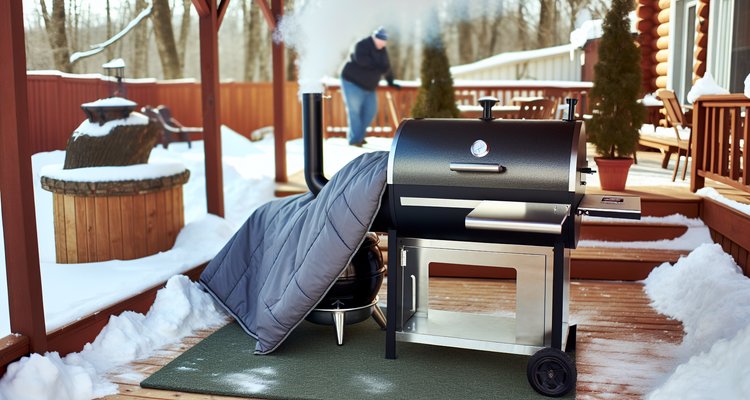
The ultimate benefit of a grill insulation blanket is the freedom it provides to pursue your passion for barbecue regardless of calendar or weather. Winter grilling transforms from a challenging ordeal into an enjoyable experience when you’re not fighting temperature drops and excessive fuel consumption. The confidence that comes from knowing your equipment will perform reliably in any conditions opens up year-round cooking possibilities.
Holiday gatherings benefit particularly from this year-round capability. Thanksgiving turkey, Christmas prime rib, and New Year’s brisket all become practical options when your pellet grill performs as reliably in December as it does in July. The ability to free up valuable indoor oven space during holiday cooking by moving proteins to your outdoor grill provides tremendous practical value for entertaining.
Beyond special occasions, year-round grilling means you never have to lose the skills and experience you’ve developed. Barbecue proficiency requires regular practice, and the ability to continue smoking and grilling through winter maintains the muscle memory and intuition that separates good pitmasters from great ones. Competition teams in northern climates particularly appreciate this continuous practice opportunity.
The psychological benefit shouldn’t be overlooked either. For many enthusiasts, grilling and smoking represent more than just cooking methods—they’re hobbies, stress relief, and social activities. A grill insulation blanket that enables year-round pursuit of this hobby provides value far beyond just fuel savings and cooking performance. The ability to step outside on a cold February evening, fire up your pellet grill, and produce outstanding barbecue brings satisfaction that transcends simple cost-benefit analysis.
How to Choose the Best Grill Insulation Blanket
Size and Compatibility
Choosing the correct size represents the single most critical factor in selecting a grill insulation blanket. An improperly sized blanket, regardless of material quality or construction, will fail to deliver optimal thermal performance. Your first step should always be identifying your exact grill model—not just the brand, but the specific series and size designation.
For example, Traeger owners need to distinguish between 22-inch, 34-inch, and Pro Series models, as each requires a different blanket size. Camp Chef 24-inch grills need different blankets than 36-inch models. This specificity ensures the blanket covers the entire combustion chamber without gaps while leaving controls, vents, and handles accessible. Most reputable insulation blanket manufacturers clearly list compatible models in their product descriptions—verify your grill appears on this compatibility list before purchasing.
If your grill model isn’t explicitly listed, take precise measurements of your combustion chamber’s width and height. Measure from the far left edge to the far right edge of the main cooking barrel, and from the bottom of the barrel to just below the lid hinge. Compare these dimensions to the blanket’s stated coverage area. A proper fit should cover the entire cooking chamber with minimal excess material, allowing the attachment system to secure the blanket without bunching or stretching.
Brand-specific blankets engineered for your exact grill model always outperform universal options. The custom cutouts, contoured edges, and precisely positioned attachment points deliver superior coverage and easier installation. While universal blankets cost less, the performance compromise rarely justifies the modest savings for serious winter grilling enthusiasts.
Material Quality
Material quality directly determines both thermal performance and longevity of your grill insulation blanket. Fire-resistant fiberglass fabric represents the industry standard and safest option for grill thermal protection. This material withstands direct contact with surfaces reaching 400-500°F without degrading, melting, or releasing harmful fumes. Verify that any blanket you consider specifically lists fire-resistant or flame-retardant certification—this isn’t just a performance feature, it’s a critical safety requirement.
Multi-layer construction separates premium blankets from basic options. Look for products describing three or more distinct layers: an inner heat-reflective layer (typically aluminum-coated fabric), a middle insulating layer (fiberglass batting or cotton), and an outer protective coating. This layered approach maximizes heat retention through multiple mechanisms—reflection, insulation, and protection—rather than relying on a single thermal barrier.
The outer coating’s quality determines durability and maintenance requirements. Waterproof and oil-proof coatings—such as polyurethane (PU) or silicone fabric—protect the insulating materials from moisture, grease, and weather exposure. These coatings should be thick enough to provide real protection while remaining flexible at low temperatures. Cheap blankets often use thin coatings that crack or peel after a few seasons of use.
Heat-resistant specifications matter for both performance and safety. Quality blankets should explicitly state their maximum temperature rating, typically 500-600°F for the outer surface. This rating ensures the blanket can handle the heat your grill generates during high-temperature cooking without degrading. Look for additional certifications like anti-aging properties, which indicate the materials maintain their insulating performance through multiple freeze-thaw cycles over several seasons.
Attachment System
The attachment system determines whether your insulation blanket stays securely in place or requires constant readjustment during cooking. Magnetic designs have become the most popular attachment method for good reason—they provide secure hold while allowing easy installation and removal. However, not all magnetic systems perform equally.
Premium magnetic blankets use heat-resistant rare-earth magnets that maintain their magnetic properties even when heated. Cheaper magnets can lose strength at elevated temperatures, causing the blanket to sag or shift during cooking. Look for products explicitly describing “heat-resistant magnets” or “high-temperature magnets.” The number and placement of magnets also matters—quality blankets typically incorporate 8-12 strategically positioned magnets around the perimeter and middle sections.
Strap-based attachment systems offer an alternative approach, particularly useful for grills with less magnetic-friendly stainless steel exteriors. Adjustable straps that secure underneath the grill provide reliable hold regardless of wind conditions. The tradeoff is slightly less convenient installation compared to magnetic systems. Some premium blankets incorporate both magnets and straps for maximum security.
Test the attachment system’s stability by considering your typical weather conditions. If you regularly grill in windy areas, prioritize blankets with robust attachment systems—either high-strength magnets, straps, or both. The last thing you want during a cook session is your blanket shifting position or pulling away from the grill surface, creating gaps that compromise thermal performance.
Coverage Area
Proper coverage area ensures maximum thermal benefit while maintaining safe grill operation. A grill insulation blanket should cover only the combustion chamber—the main barrel where cooking occurs. It must never cover air intake vents, the chimney stack, or the hopper area where pellets are stored. Blocking these ventilation points creates dangerous conditions including incomplete combustion, carbon monoxide buildup, and potential fire hazards.
Quality blankets are designed with specific ventilation requirements in mind. They cover the maximum surface area possible while deliberately leaving critical airflow paths unobstructed. When evaluating a blanket, verify the product photos and descriptions clearly show exposed vents and chimney. If a product claims to “completely wrap” your grill or “cover all surfaces,” that’s a red flag indicating potentially unsafe design.
Access to temperature controls and gauges should remain unobstructed. You need to adjust settings and monitor temperatures throughout your cook without removing the entire blanket. Well-designed blankets include cutouts or positioned edges that leave control panels accessible. This design consideration becomes particularly important during long smoking sessions where you’ll make multiple temperature adjustments.
The blanket shouldn’t interfere with normal grill operation, especially lid opening and closing. When draped correctly, you should be able to open your grill lid fully without the blanket catching, bunching, or needing removal. This clearance allows quick food checks without disrupting the thermal protection during the majority of cook time when the lid remains closed.
Ease of Maintenance
Maintenance requirements significantly impact long-term satisfaction with your grill insulation blanket. Look for materials that clean easily with a damp cloth rather than requiring machine washing or special cleaning products. The outer coating should repel grease, smoke residue, and pellet dust, allowing quick wipe-downs between uses.
Storage convenience matters for equipment you’ll use seasonally. Quality blankets should fold or roll compactly for storage during warmer months when thermal insulation isn’t needed. Avoid blankets with rigid reinforcements or materials that resist folding, as these prove difficult to store in limited garage or shed space. Some manufacturers include storage bags with their blankets—a nice convenience feature for keeping the blanket clean and protected during off-season storage.
Durability determines whether your investment lasts multiple seasons or requires replacement after a single winter. Read product descriptions carefully for terms like “heavy-duty,” “reinforced stitching,” and “anti-aging materials.” These indicators suggest the manufacturer designed the product for longevity rather than treating it as a disposable seasonal item. While you’ll pay slightly more for premium durability, the cost-per-season calculation favors quality construction that lasts 3-5 years over cheap options requiring annual replacement.
Consider warranty coverage as a proxy for manufacturer confidence in their product’s durability. Companies offering 1-2 year warranties typically stand behind their construction quality. Limited or no warranty coverage often indicates lower-quality materials and construction that won’t survive multiple seasons of use.
Top 6 Grill Insulation Blankets – Detailed Reviews
Stanbroil Grill Insulation Blanket for Traeger 34 Series and Texas Grill – Best Overall
The Stanbroil insulation blanket designed for Traeger 34 Series and Texas Grill models represents the gold standard for Traeger owners seeking reliable cold-weather performance. This brand-specific blanket features precision engineering that conforms perfectly to the unique shape of these popular grill models, with custom cutouts positioned exactly where controls and handles are located.
Highlights
- Fire, water, and oil-resistant fiberglass fabric construction for safety and durability
- Maximizes fuel efficiency and dramatically reduces pellet consumption in cold conditions
- Allows grilling at higher temperatures by trapping heat in the combustion chamber
- Easy maintenance with simple damp cloth cleaning
- Compatible with all Texas and 34 Series grill models (excludes Century 34)
Specifications
- Material: Fire-resistant, water-resistant, and oil-resistant fiberglass fabric
- Temperature Recommendation: Not recommended for use above 40°F outside temperature
- Compatibility: Traeger 34 Series and Texas Grill models
- Attachment: Magnetic design
- Maintenance: Easy damp cloth cleaning
Customer Reviews
- “This blanket delivers exceptional performance for my Traeger 34 Series with 40-50% reductions in pellet usage.”
- “The fire-resistant fiberglass construction ensures safe operation even during extended high-temperature cooking.”
- “Straightforward installation process and minimal maintenance requirements make this excellent for winter grilling.”
BBQ Butler Smoker Insulation Blanket for Traeger Pro 575, Pro 22 Series and Lil’ Tex Elite – Best for Traeger Pro Series
BBQ Butler’s thermal blanket specifically engineered for Traeger Pro Series grills provides Pro 575, Pro 22, and Lil’ Tex Elite owners with reliable thermal protection designed around their grill’s exact dimensions. This blanket emphasizes maximum heat retention and fuel efficiency, making it an ideal choice for serious pellet grill enthusiasts who cook frequently in cold conditions.
Highlights
- Reaches higher temperatures by trapping heat inside the grill chamber
- Minimizes heat loss to use fewer pellets and maximize fuel efficiency
- Protective outer layer shields smoker from harsh weather including wind, rain, and snow
- Enables year-round grilling capability regardless of outdoor conditions
- Custom fit for Traeger Pro 575, Pro 22 Series, Lil’ Tex Elite, and Pro 20 models
Specifications
- Material: Thermal insulated material with protective weather-resistant outer layer
- Temperature Recommendation: Not recommended for use above 40°F outside temperature
- Compatibility: Traeger Pro 575, Pro 22 Series, Lil’ Tex Elite, Pro 20
- Features: Weather-resistant protection
- Design: Custom engineered for Pro Series models
Customer Reviews
- “The emphasis on heat retention delivers consistent results during long smoking sessions.”
- “Weather-resistant outer layer provides crucial protection during winter storms.”
- “Maintains stable temperatures during frequent lid openings—essential for competition-style cooks.”
Stanbroil Insulated Blanket for Camp Chef 36″ Smokepro Pellet Grills – Best for Camp Chef
Stanbroil’s Camp Chef-specific insulation blanket showcases premium multi-layer construction designed for the larger 36-inch Smokepro models. This blanket stands out for its sophisticated triple-layer design and innovative magnetic attachment system that keeps the blanket securely in place even during windy conditions.
Highlights
- Perfect custom fit for Camp Chef 36″ Pellet Grills including SGX36, LUX36, PG36SGX, and PG36LUX models
- Reduces pellet consumption by eliminating heat loss through the grill walls
- Triple layer construction: aluminum fiberglass fabric, insulating cotton middle layer, and PU-coated fiberglass exterior
- Magnetic design with strategically placed heat-resistant magnets holds blanket securely on windy days
- Easy to clean with simple damp cloth wipe-down
Specifications
- Dimensions: 37 x 36 inches
- Material: Triple layer construction—aluminum fiberglass fabric inner layer, insulating cotton middle, PU-coated fiberglass outer layer
- Compatibility: Camp Chef 36″ models (SGX36, LUX36, PG36SGX, PG36LUX)
- Attachment: Magnetic design with heat-resistant magnets
- Maintenance: Damp cloth cleaning
Customer Reviews
- “The aluminum fiberglass inner layer reflects radiant heat back toward the grill chamber perfectly.”
- “Magnetic attachment system proves particularly valuable for Camp Chef’s larger 36-inch grills.”
- “Achieved 12+ hour brisket cooks on a single hopper of pellets in freezing temperatures.”
Z GRILLS Thermal Insulation Blanket for ZPG-450A – Best Budget
Z GRILLS’ model-specific thermal blanket for the ZPG-450A represents an excellent value option for owners of this popular compact pellet grill. Despite its budget-friendly positioning, this blanket features upgraded fire-resistant materials and a reliable magnetic attachment system that delivers performance comparable to premium alternatives.
Highlights
- Upgraded fire-resistant fiberglass construction for safety and longevity
- Unique magnetic design with heat-resistant magnets for secure attachment
- Maintains consistent temperatures in harsh weather conditions
- Fire-resistant, waterproof, and dust-proof protection
- Reduces pellet consumption for maximum fuel efficiency
Specifications
- Material: Upgraded fire-resistant fiberglass
- Compatibility: Z GRILLS ZPG-450A model
- Attachment: Magnetic design with heat-resistant magnets
- Protection: Fire-resistant, waterproof, and dust-proof
- Performance: Maintains consistent temperatures in harsh weather
Customer Reviews
- “Solid performance in temperatures down to 20°F with noticeable improvements in temperature control.”
- “The upgraded fire-resistant fiberglass provides essential thermal protection at a budget price.”
- “Waterproof and dust-proof construction extends the blanket’s lifespan significantly.”
Z GRILLS Thermal Blanket for 600 Series, 700 Series, 1000 Series Pellet Grill & Smoker – Best for Larger Grills
Z GRILLS’ versatile insulation blanket designed to accommodate multiple grill series—including 600, 700, and 1000 models—provides exceptional flexibility for owners of larger Z GRILLS units. This weather-resistant blanket emphasizes broad compatibility while maintaining the thermal performance expected from brand-specific designs.
Highlights
- Unique magnetic design with strategically positioned heat-resistant magnets
- Weather-resistant protective insulation cover shields from wind, rain, and snow
- Maintains consistent temperatures in harsh weather conditions
- Reduces pellet consumption significantly in cold weather
- Customized fit for Z GRILLS 600 Series, 700 Series, and 1000 Series models
Specifications
- Material: Weather-resistant protective insulation material
- Compatibility: Z GRILLS 600 Series, 700 Series, and 1000 Series
- Attachment: Magnetic design with heat-resistant magnets
- Protection: Weather-resistant cover
- Design: Multi-series compatibility
Customer Reviews
- “The customized fit ensures proper coverage across the 600, 700, and 1000 series perfectly.”
- “Weather-resistant construction proves valuable in regions with severe winter conditions.”
- “Maintains stable temperatures even in sub-zero conditions on my Z GRILLS 700 Series.”
Hisencn Grill Thermal Insulation Blanket for Pit Boss Pro 850, 800 Series – Best for Pit Boss
Hisencn’s heavy-duty grill insulation blanket designed for Pit Boss Pro Series models stands out for its premium silicone fabric construction and impressive multi-brand compatibility. This blanket emphasizes maximum durability and delivers some of the most substantial fuel savings among all options reviewed.
Highlights
- Premium silicone fabric surface with fiberglass cotton insulation inside
- Waterproof, oil-proof, fire retardant, and anti-aging properties
- Reduces pellet consumption by 25%-50% in cold conditions
- Reduces cooking time by at least 20% through superior heat retention
- Super heavy-duty construction with strong heat-resistant magnets
Specifications
- Material: Premium silicone fabric outer surface with fiberglass fabric cotton insulation interior
- Temperature Recommendation: Not recommended for use above 40°F outside temperature
- Compatibility: Pit Boss 820 Deluxe, Pro 850, 800 Series (820FB, 820S, 820SC), and Z Grill 700 Series
- Performance: 25-50% pellet savings, 20% faster cooking
- Construction: Super heavy-duty with reinforced stitching
Customer Reviews
- “The silicone fabric surface offers superior durability compared to standard coated fiberglass.”
- “Achieved 25-50% pellet savings during extended smoking sessions in temperatures below 30°F.”
- “Super heavy-duty construction with reinforced stitching ensures this blanket survives multiple seasons.”
Frequently Asked Questions
At what temperature should I use a grill insulation blanket?
The general guideline recommends using a grill insulation blanket when outside temperatures reach 35-40°F or colder. Below this threshold, pellet grills and smokers begin experiencing noticeable performance issues including increased pellet consumption, difficulty maintaining target temperatures, and longer preheat times. However, temperature alone doesn’t tell the complete story.
Wind conditions significantly impact when thermal insulation becomes beneficial. A calm 40°F day might not require a blanket, but add 15-20 mph winds and the wind chill effect dramatically increases heat loss from your grill. Similarly, if you’re planning extended smoking sessions lasting 6+ hours in temperatures below 50°F, an insulation blanket ensures consistent performance throughout the entire cook.
Conversely, avoid using thermal blankets when outside temperatures exceed 60°F in calm conditions. The additional insulation can cause your grill to run excessively hot, creating temperature control challenges and potentially stressing heating elements. Most manufacturers specifically recommend against use above 40°F, as the blanket’s insulating properties become counterproductive in warmer weather.
How much can I save on pellets with an insulation blanket?
Real-world testing and user experiences consistently demonstrate 25-50% reductions in pellet consumption when using a quality insulation blanket in temperatures below 40°F. The exact savings depend on several factors including outside temperature, wind conditions, and cooking duration, but the fuel efficiency improvements are substantial regardless of specific conditions.
To quantify this with concrete numbers: uninsulated pellet grills in freezing temperatures typically consume 3.0-3.3 pounds of pellets per hour to maintain smoking temperatures around 225°F. Install a proper grill insulation blanket and that consumption drops to 1.8-2.0 pounds per hour for identical temperature targets. Over an 8-hour brisket cook, this represents savings of 8-12 pounds of pellets per session.
For winter grilling enthusiasts who smoke 2-3 times monthly during cold months, the annual pellet savings range from $100-200—meaning even premium blankets pay for themselves within a single season. Factor in the extended equipment life from reduced heating system stress, and the long-term value proposition becomes even more compelling.
Will an insulation blanket work on my grill model?
Brand-specific grill insulation blankets are engineered for particular grill models and brands, so compatibility verification is essential before purchasing. Reputable manufacturers clearly list compatible models in their product descriptions—always verify your exact grill model appears on this list. For example, Traeger blankets distinguish between 22-inch, 34-inch, Pro Series, and other specific models, each requiring different blanket designs.
If your grill model isn’t explicitly listed, you have two options: contact the manufacturer to confirm compatibility, or take precise measurements of your combustion chamber and compare them to the blanket’s stated dimensions. Measure your grill’s cooking barrel width and height, then verify the blanket covers this area with minimal excess material. Proper fit ensures the blanket covers the entire combustion chamber without gaps while leaving controls, vents, and handles accessible.
Universal insulation blankets claim to fit multiple brands and sizes, but these rarely deliver the same performance as brand-specific options. The imprecise fit often results in gaps, loose areas, and poor alignment with controls. For optimal thermal performance and ease of use, invest in a blanket specifically designed for your exact grill model rather than attempting to make a universal option work.
Can I use an insulation blanket in the summer?
Using a grill insulation blanket in warm weather above 60°F is not recommended and can actually create performance problems rather than benefits. The additional insulation prevents normal heat dissipation, causing your grill to run hotter than target temperatures and making precise temperature control difficult. Your grill’s heating system may cycle excessively or struggle to maintain lower smoking temperatures when over-insulated in warm conditions.
Most manufacturers explicitly state their blankets should not be used above 40°F outside temperature. This guideline exists because the blanket’s thermal protection—so beneficial in cold weather—becomes counterproductive when ambient temperatures already allow efficient grill operation. Using the blanket in warm weather can also cause unnecessary wear on your grill’s components as the heating system works to dissipate excess heat.
The transition seasons—spring and fall—require judgment based on specific conditions. If daytime temperatures reach 55-60°F but you’re cooking in the evening when temperatures drop to 40-45°F with wind, the blanket provides value. However, for summer grilling in temperatures consistently above 65°F, store your insulation blanket until cold weather returns. This seasonal approach maximizes both the blanket’s benefits and its longevity.
How do I clean and store my insulation blanket?
Proper maintenance extends your grill insulation blanket’s lifespan significantly. After each use, allow the blanket to cool completely before cleaning—this typically takes 20-30 minutes after your cook session ends. Once cooled, use a damp cloth or sponge to wipe down the exterior surface, removing any grease splatters, pellet dust, or smoke residue. The oil-resistant outer coating on quality blankets allows most contaminants to wipe away easily without requiring harsh cleaners or scrubbing.
Avoid machine washing unless the manufacturer specifically recommends it, as washing machines can damage the multi-layer construction and compromise the blanket’s insulating properties. The fiberglass materials and protective coatings aren’t designed for tumbling action and detergent exposure. Similarly, never use harsh chemical cleaners or degreasers, as these can degrade the fire-resistant treatments and waterproof coatings.
For storage during warmer months when the blanket isn’t needed, fold or roll it loosely and keep it in a dry location protected from direct sunlight and moisture. Many owners store their blankets in large plastic storage bins or the original packaging if available. Avoid compressing the blanket heavily during long-term storage, as this can damage the insulating layers. Some grillers loosely drape their blanket over the grill during storage, providing dust protection while avoiding compression. Before using after storage, inspect the blanket for any damage, ensuring magnets remain secure and materials show no signs of deterioration.
Are insulation blankets safe to use?
Quality grill insulation blankets designed specifically for pellet grills and smokers are safe when used according to manufacturer instructions. These blankets use fire-resistant or flame-retardant fiberglass materials that withstand direct contact with hot grill surfaces reaching 400-500°F without melting, burning, or releasing harmful fumes. This fire-resistant construction is a fundamental safety feature that separates proper grill blankets from inappropriate alternatives like regular welding blankets or fabric covers.
Critical to safe operation: never cover your grill’s air intake vents, chimney stack, or hopper area. Proper insulation blankets are designed to cover only the combustion chamber, deliberately leaving ventilation paths open. Blocking these vents creates dangerous conditions including incomplete combustion, carbon monoxide buildup, and potential fire hazards. Quality blankets feature cutouts and positioning that maintain proper airflow while maximizing thermal benefit.
The magnetic or strap attachment systems used on modern blankets hold the blanket securely in place, preventing accidental contact with hot surfaces or the blanket falling onto the grill’s heating system. This secure attachment is both a safety feature and performance benefit. However, always verify the blanket is positioned correctly before starting your grill, ensuring no material drapes over vents or touches moving parts.
One important safety consideration: while the blanket itself is fire-resistant, it does create a hotter grill exterior surface during use. The trapped heat that provides such excellent cooking performance also means the outer blanket surface can reach 200-300°F. Exercise appropriate caution when touching the blanket during cooking, and keep children and pets away from the grill when the insulation blanket is installed and the grill is operating. This is no different from the caution required around any hot grill, but the blanket does extend the hot surface area beyond just the grill’s metal body.
Conclusion
A quality grill insulation blanket transforms winter grilling from a challenging endeavor into an enjoyable experience that delivers results comparable to perfect summer weather. The benefits extend far beyond just comfort—25-50% reductions in pellet consumption, dramatically improved temperature control, and the confidence to pursue your passion for barbecue year-round represent genuine value for any serious griller.
The key to maximizing these benefits lies in selecting the right blanket for your specific grill model. Brand-specific designs engineered for Traeger, Camp Chef, Z GRILLS, Pit Boss, and other popular brands deliver superior performance compared to universal alternatives. The precision fit, proper ventilation, and secure attachment systems of model-specific blankets ensure you get the full thermal benefit without compromising safety or convenience.
Whether you’re a competition pitmaster maintaining skills through winter, a holiday host who needs reliable equipment for special occasion cooks, or simply an enthusiast who refuses to let cold weather interrupt your grilling schedule, an insulation blanket represents one of the most cost-effective investments you can make in your outdoor cooking setup. The fuel savings alone typically justify the cost within a single season, while the improved consistency and expanded cooking capabilities provide value that transcends simple financial calculations.
Review our top 6 recommendations above to find the perfect thermal blanket for your grill model. Each option has been selected for specific strengths—whether that’s premium construction, budget-friendly value, multi-model compatibility, or heavy-duty durability. Match your needs to the right blanket, and you’ll wonder how you ever managed cold weather grilling without this essential accessory.
Don’t let winter put your grill into hibernation. With the right grill insulation blanket, every season is grilling season, and every cook delivers the consistent, flavorful results you’ve come to expect from your pellet grill or smoker. Fire up that grill, embrace the winter grilling challenge, and enjoy outstanding barbecue regardless of what the thermometer says.
Contents


